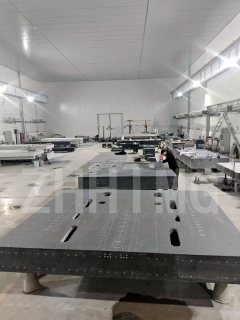The difference of thermal expansion coefficient between precision granite component and precision ceramic component and its application in high precision equipment
In the pursuit of high precision and stability in the industrial field, the coefficient of thermal expansion of materials becomes a crucial consideration. Precision granite components and precision ceramic components, as two kinds of materials widely used in high-precision equipment, their thermal expansion coefficient difference has a significant impact on equipment performance.
Difference in coefficient of thermal expansion
Precision granite components:
Granite as a natural stone, its thermal expansion coefficient is relatively low, generally between 8×10^-6/℃ ~ 10×10^-6/℃. This means that when the temperature changes, the size change of the granite component is relatively small, which is conducive to maintaining the stability and accuracy of the equipment. In addition, granite also has good compressive strength, durability and wear resistance, making it a commonly used high-precision equipment workbench, bed and other components of the material.
Precision ceramic components:
In contrast, the coefficient of thermal expansion of precision ceramic components is lower, usually much lower than that of metal materials such as stainless steel. This low coefficient of thermal expansion of precision ceramics enables it to maintain extremely high dimensional stability and accuracy under extreme temperature changes. This is particularly important for equipment that needs to work in high-precision conditions for a long time, such as aerospace equipment, precision measuring instruments, etc.
Impact on high-precision equipment
Accuracy retention:
In high-precision equipment, any small size change can have a significant impact on the overall performance of the equipment. Precision granite components and precision ceramic components, due to their low coefficient of thermal expansion, are able to maintain small dimensional changes when the temperature changes, thus ensuring the long-term accuracy and stability of the equipment. This is especially important for equipment that requires high precision measurement, such as coordinate measuring machines, lithography machines, etc.
Matchmaking:
In high-precision equipment, the match between different components is also one of the key factors affecting the performance of the equipment. Due to the difference in the coefficient of thermal expansion between precision granite components and precision ceramic components, this difference needs to be fully considered in the design and manufacturing process to ensure a good match between the components. For example, when combining precision ceramic components with metal components, special connection methods and materials are required to reduce stress concentration and deformation problems caused by differences in thermal expansion coefficients.
Comprehensive application:
In practical applications, precision granite components and precision ceramic components are often selected and used according to specific needs. For example, in high-precision measuring instruments, precision granite components can be used as workbench and bed materials to ensure the stability and accuracy of the equipment; At the same time, in parts that require higher accuracy and smaller dimensional changes, precision ceramic components can be manufactured. This comprehensive application can give full play to the advantages of the two materials and improve the overall performance and reliability of the equipment.
In summary, the difference in thermal expansion coefficient between precision granite components and precision ceramic components has an important impact on the application of high-precision equipment. Through the reasonable selection and use of these two materials, we can ensure that the equipment can still maintain high precision and stability in the temperature change environment, so as to meet the needs of various high-precision machining and measurement.
Post time: Aug-07-2024

